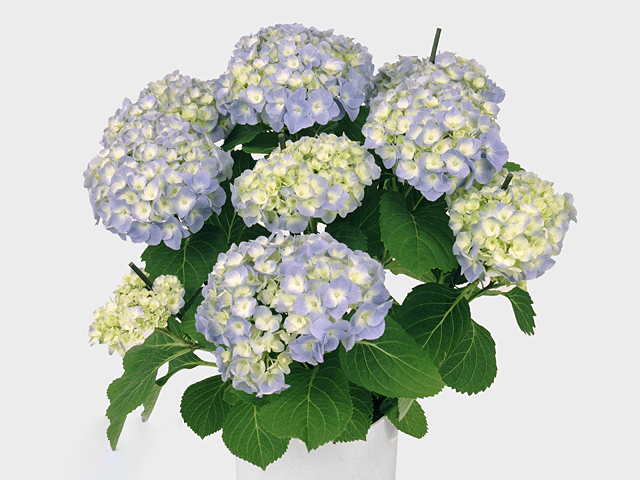Hydrangea macrophylla 'Bodensee'

| Leaf tip | Acuminate |
| Leaf margin | Serrate |
| Leaf type | Foliage leaf |
| Winter hardness | Good (USDA-zone 5, 6) |
| Plant height | 80 - 90 cm; 90 - 100 cm |
| Flowering month(s) | July; August; September |
| Structure (tissues) | Woody |
| Leaf duration | Deciduous |
| soil pH requirement | Neutral (pH 6,5 - 7,5); Alkaline (pH > 7,5); Slightly acidic (pH 4,5 - 6,5) |
| Light conditions | Semi-shades; Sunny |
| Leaf division | Simple |
| Plant, growth type | Erect |
| Toxicity (if consumed) | Not or barely |
| Moisture requirements | Well-drained; Moist |
The Hydrangea macrophylla 'Bodensee', commonly known as the hydrangea, is a popular flowering plant known for its stunning blooms and attractive foliage. With its various features and requirements, it is a versatile addition to any garden or landscape.
One notable characteristic of the Hydrangea macrophylla 'Bodensee' is its leaf structure. The leaves are large and have an acuminate tip, which tapers to a sharp point. The leaf margin is serrate, with small teeth along the edges, adding texture and interest to the foliage. These leaves are foliage leaves, meaning they serve primarily as greenery and not for photosynthesis.
When it comes to winter hardiness, the Hydrangea macrophylla 'Bodensee' is considered good, suitable for USDA hardiness zones 5 and 6. This means it can withstand colder temperatures and is well-suited for regions with milder winters. The plant typically reaches a height of 80 to 90 cm or 90 to 100 cm, depending on the specific variety.
One of the main attractions of the Hydrangea macrophylla 'Bodensee' is its stunning flowers, which bloom from July to September. These blooms bring vibrant colors to the garden, with shades of blue, pink, or purple, depending on the soil pH. This hydrangea is unique in that the flower color can be altered by changing the soil's acidity. A more alkaline soil will result in pink flowers, while acidic soil will produce blue flowers. If the soil is slightly acidic, the blooms may feature a beautiful combination of blue and pink.
The Hydrangea macrophylla 'Bodensee' is a woody plant, meaning it has strong and durable tissues that provide structure and support. However, despite its woody nature, it is a deciduous plant, meaning it sheds its leaves in the autumn.
In terms of soil pH requirements, the Hydrangea macrophylla 'Bodensee' prefers a neutral to slightly acidic soil with a pH range of 6.5 to 7.5. However, it can also tolerate slightly alkaline soil with a pH greater than 7.5. It is important to maintain the proper pH to ensure optimal growth and bloom color.
When it comes to light conditions, the Hydrangea macrophylla 'Bodensee' thrives in semi-shades to sunny areas. While it can tolerate some shade, it prefers an ample amount of sunlight to promote healthy growth and abundant blooms.
The leaves of the Hydrangea macrophylla 'Bodensee' are simple, meaning they are not divided into multiple leaflets. The plant has an erect growth habit, growing upright and providing a natural vertical element to the garden or landscape.
While many plants can be toxic if consumed, the Hydrangea macrophylla 'Bodensee' is considered to be non-toxic or only mildly toxic if ingested. However, it is still important to keep children and pets away from the plant to avoid any potential harm.
Finally, the Hydrangea macrophylla 'Bodensee' prefers well-drained soil that retains moisture. It is important to ensure that the plant is not sitting in waterlogged soil, as this can lead to root rot. However, it also requires adequate moisture to thrive, so regular watering is necessary, especially during dry periods.
In conclusion, the Hydrangea macrophylla 'Bodensee' is a beautiful and versatile plant that offers stunning blooms, attractive foliage, and a range of growth requirements. With its leaf structure, winter hardiness, flower color-changing ability, and preferences for light, soil pH, and moisture, it is a wonderful addition to any garden or landscape.
Market availability index by month:
| Jan. | Feb. | Mar. | Apr. | May | Jun. | Jul. | Aug. | Sep. | Oct. | Nov. | Dec. |
|---|---|---|---|---|---|---|---|---|---|---|---|
| 1 | 1 | 2 | 4 | 4 | 3 | 3 | 2 | 1 | 1 | 1 | 1 |